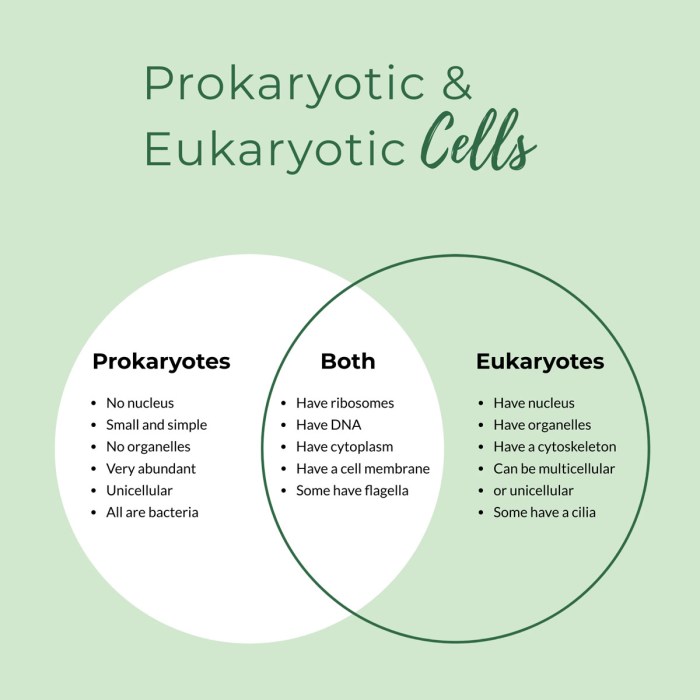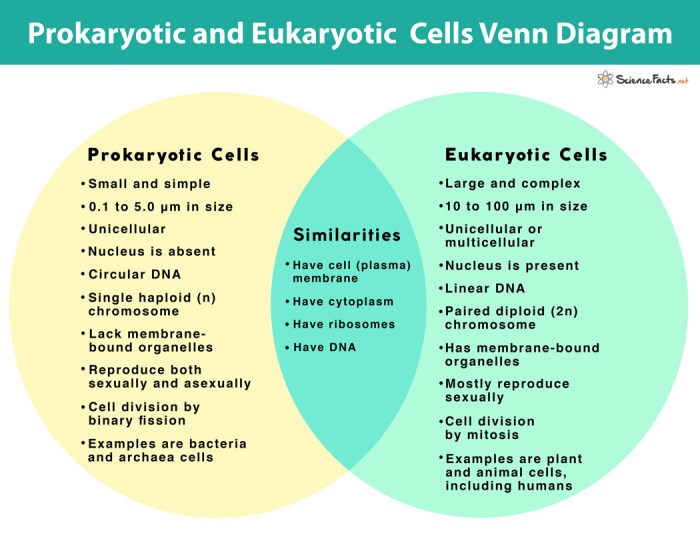The Venn diagram of eukaryotes and prokaryotes sets the stage for this enthralling narrative, offering readers a glimpse into a story that is rich in detail and brimming with originality from the outset. This visual representation of overlapping sets provides a framework for understanding the key similarities and differences between these two fundamental cell types, shaping our comprehension of the diversity of life on Earth.
As we delve into the intricacies of eukaryotes and prokaryotes, we will uncover the fundamental distinctions that set them apart, such as their contrasting cell structures, genetic material, and metabolic pathways. Through a comparative analysis, we will unravel the evolutionary implications of these variations, gaining insights into the origins and diversification of life.
Overview of Venn Diagram

A Venn diagram is a visual representation of overlapping sets. It consists of two or more circles that intersect to show the common elements between the sets. For example, a Venn diagram with two overlapping circles could represent the sets of “animals” and “mammals.”
The overlapping area would represent the animals that are also mammals, such as dogs and cats.
Comparison of Eukaryotes and Prokaryotes

Eukaryotes and prokaryotes are two types of cells that differ in their structure, genetic material, and other characteristics. Eukaryotes are more complex than prokaryotes and have a nucleus, membrane-bound organelles, and a cytoskeleton. Prokaryotes are simpler and lack a nucleus, membrane-bound organelles, and a cytoskeleton.
| Characteristic | Eukaryotes | Prokaryotes |
|---|---|---|
| Cell size | 10-100 micrometers | 1-10 micrometers |
| Cell structure | Complex, with a nucleus, membrane-bound organelles, and a cytoskeleton | Simple, with no nucleus, membrane-bound organelles, or a cytoskeleton |
| Genetic material | DNA is organized into chromosomes within the nucleus | DNA is organized into a single, circular chromosome in the cytoplasm |
Venn Diagram of Eukaryotes and Prokaryotes

The Venn diagram below represents the similarities and differences between eukaryotes and prokaryotes.

The overlapping area represents the shared features between eukaryotes and prokaryotes, such as their basic cell structure and metabolism. The non-overlapping areas represent the unique characteristics of each type of cell.
Similarities between Eukaryotes and Prokaryotes

Eukaryotes and prokaryotes share some basic features, such as:
- A cell membrane
- Cytoplasm
- Ribosomes
- DNA
- Basic metabolism
These similarities suggest that eukaryotes and prokaryotes evolved from a common ancestor.
Differences between Eukaryotes and Prokaryotes
Eukaryotes and prokaryotes also have some key differences, such as:
- Cell size:Eukaryotes are typically larger than prokaryotes.
- Cell structure:Eukaryotes have a nucleus, membrane-bound organelles, and a cytoskeleton, while prokaryotes do not.
- Genetic material:Eukaryotic DNA is organized into chromosomes within the nucleus, while prokaryotic DNA is organized into a single, circular chromosome in the cytoplasm.
These differences reflect the different evolutionary histories of eukaryotes and prokaryotes.
Q&A: Venn Diagram Of Eukaryotes And Prokaryotes
What is the primary difference between eukaryotes and prokaryotes?
The most significant difference between eukaryotes and prokaryotes lies in their cellular organization. Eukaryotes possess a nucleus and other membrane-bound organelles, while prokaryotes lack these structures and have a simpler cellular architecture.
What are the key similarities between eukaryotes and prokaryotes?
Despite their differences, eukaryotes and prokaryotes share certain fundamental characteristics, including the presence of DNA as their genetic material, ribosomes for protein synthesis, and a plasma membrane that surrounds the cell.
How can a Venn diagram help us understand the relationship between eukaryotes and prokaryotes?
A Venn diagram provides a visual representation of the overlapping and non-overlapping characteristics of eukaryotes and prokaryotes. It allows us to identify their shared features, as well as the unique traits that distinguish each cell type.
